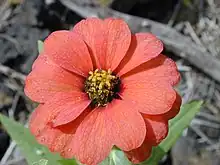Zinnia peruviana
Zinnia peruviana, the Peruvian zinnia, is an annual flowering plant in the family Asteraceae. It is native to North America and South America.
| Peruvian zinnia | |
|---|---|
_(12008612756).jpg.webp) | |
| Scientific classification | |
| Kingdom: | Plantae |
| Clade: | Tracheophytes |
| Clade: | Angiosperms |
| Clade: | Eudicots |
| Clade: | Asterids |
| Order: | Asterales |
| Family: | Asteraceae |
| Genus: | Zinnia |
| Species: | Z. peruviana |
| Binomial name | |
| Zinnia peruviana | |
| Synonyms[1] | |
|
Synonymy
| |
Description
Zinnia peruviana is an annual plant up to 50 cm tall (rarely 100 cm tall).[2][3] The stems are green, but later become yellow or purple.[3] The leaves are ovate, elliptic or lanceolate, 2.5–7 cm long and 8–3.5 cm wide; 3- to 5-nerved.[2][3] The peduncles are 1–7 cm long.[2][3] Flower heads with 6–21 red, maroon or yellow ray florets (with a 0.8–2.5 cm long petal each) surrounding 12–50 yellow disc florets (with 0.1 cm long corolla lobes).[2][3] Fruits (cypselae) oblanceolate to narrowly elliptic, 0.7–1 cm long, 3-angled or compressed, striate.[2][3]

Distribution and habitat
The native range of Z. peruviana spans from southeastern Arizona and the Greater Antilles south to Argentina.[2][3] It grows mostly on open areas or rocky slopes between 800–3000 m of elevation.[3][4]
It has been introduced to and naturalized in many places such as China, Pakistan, India, Bangladesh, Australia, South Africa and Hawaii.[5][6][7][8][9]
References
- The Plant List, Zinnia peruviana (L.) L.
- "Zinnia peruviana in Flora of North America @ efloras.org". www.efloras.org. Retrieved 2017-10-11.
- Torres, Andrew M. (1963). "Taxonomy of Zinnia". Brittonia. 15 (1): 1–25. doi:10.2307/2805035. ISSN 0007-196X. JSTOR 2805035. S2CID 5342830.
- Nash, Dorothy; Williams, Louis (1976). "Flora of Guatemala". Fieldiana. v.24:pt.12: 359–360.
- "Zinnia peruviana - Plants of Hawaii - Starr Environmental". www.starrenvironmental.com. Retrieved 2017-10-11.
- "Zinnia peruviana | Atlas of Living Australia". bie.ala.org.au. Retrieved 2017-10-11.
- Germishuizen, G.; Meyer, N. (2003). Plants of southern Africa : an annotated checklist. Pretoria: National Botanical Institute. p. 310. ISBN 1919795995. OCLC 54957425.
- "Zinnia peruviana in Flora of China @ efloras.org". www.efloras.org. Retrieved 2017-10-11.
- Sud, Gunjan (2016). "Zinnia peruviana L. (Asteraceae) an overlooked Species from Himachal Pradesh". Indian Forester. 142 (8): 795–796. ISSN 2321-094X.